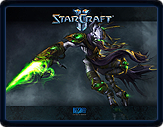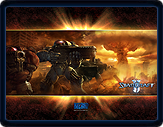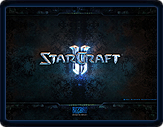Blizzard Entertainment began development on StarCraft in 1995, shortly after the release of highly successful Warcraft II: Tides of Darkness. Using the Tides of Darkness’s game engine as a base, StarCraft made its debut at E3 1996. The version of the game displayed, assembled by the team’s lead programmer Bob Fitch, received a rather weak response from the convention and was criticized by many for being “Warcraft in space.” As a consequence the entire project was overhauled, bringing the focus onto creating three distinct species. Bill Roper, one of the game’s producers, stated this would be a major departure from the Warcraft approach, comparing its two equal sides to those of chess and stating that StarCraft would allow players to “develop very unique strategies based on which species [is being played], and will require [players] to think of different strategies to combat the other two species.” In early 1997, the new version of StarCraft was unveiled, receiving a far more positive response.
However, the game was still marred by technical difficulties, so Bob Fitch completely redesigned the Warcraft II engine within two months to ensure that many of the features desired by the designers, such as the abilities for units to burrow and cloak, could be implemented. Later improvements to the game included pre-rendered sprites and backgrounds, constructed using 3D Studio Max. An isometric in-game view was also adopted, in contrast to Warcraft II’s 3/4s birdseye perspective. In addition, the game utilized high quality music, composed by Blizzard’s resident composers, and professional voice actors were hired.
Despite the progress, StarCraft was slow to emerge. The continual delays inspired a group of StarCraft fans on the official forums who labeled themselves “Operation: Can’t Wait Any Longer” to write a series of fictional stories in which the members of Operation CWAL attempted to retrieve the beta version of StarCraft from Blizzard’s headquarters in Irvine, California. To pay homage to their presence on the forums and enthusiasm for the game, Blizzard Entertainment later incorporated the group’s name into StarCraft as a cheat code to speed up the production of units and gave the group thanks in the game’s credits. The game was released for Windows on 31 March 1998, with the Mac OS version following a year later in March 1999. Development on a Nintendo 64 version, StarCraft 64, began in 1999, converted from PC by Mass Media Interactive Entertainment—a subsidiary of THQ—and published by Nintendo. StarCraft 64 was released on 13 June 2000 in the USA and on 16 June 2000 in Europe.
Audio
The musical score to StarCraft was composed by Blizzard Entertainment’s in-house composers. Derek Duke and Glenn Stafford composed the tracks in the menus and the in-game music, while Jason Hayes composed the music used in the cinematic cut scenes. Tracy W. Bush provided additional support in composing. The musical score of the game was received well by reviewers, who have described it as “appropriately melodic and dark” and “impressive”, with one reviewer noting that some of the music owed much of its inspiration to Jerry Goldsmith’s score for the film Alien. The first official game soundtrack, StarCraft: Game Music Vol. 1, was released in 2000, comprising tracks from both StarCraft and Brood War, as well as a sizable portion of remix tracks and music inspired by StarCraft, created by several South Korean disc jockeys. The soundtrack was distributed by Net Vision Entertainment. In September 2008, Blizzard Entertainment announced that a second soundtrack, StarCraft Original Soundtrack, had been released on iTunes. This soundtrack consisted entirely of the original music from StarCraft and Brood War, both from in-game themes to music used in the cinematic cut scenes.



